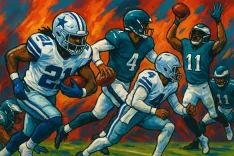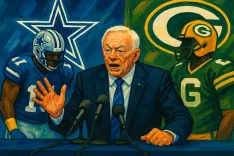Fantasy Football Draft Strategies: Players to Avoid in 2025

As the 2025 NFL season approaches, many fantasy football managers are preparing for their drafts with a clear strategy centered around targeting specific players. However, it is equally important for these managers to identify players to avoid at their typical draft costs. Selecting a league-winner can significantly enhance a manager's chances of success, but steering clear of potential first-round flops and early busts may prove to be just as crucial. With running backs often experiencing the highest attrition rates, it is worthwhile to spotlight three notable players at this position whose warning signs may not justify their elevated prices.
Christian McCaffrey presents an intriguing case with a ceiling that could elevate him to the top of fantasy football rankings if he manages to stay healthy throughout the season. Yet, his downside is equally significant. The caveat 'if healthy' looms large, as McCaffrey has been limited to seven games or fewer in three of the last five seasons, including a mere four appearances in 2024. Approaching his 30th birthday—a milestone often perceived as precarious for running backs—his previous season was far from impressive. Despite being constrained by injuries, his performance when active revealed further concerns; he averaged just 5.4 yards per touch, marking the second-lowest figure of his career. Fantasy managers face a dilemma when considering drafting him in the first round, as the potential upside does not sufficiently compensate for the associated risks.
Javonte Williams, despite finishing as one of the top five running backs in standard fantasy points last season, raises similar questions for prospective drafters. On the surface, his production seems commendable, yet a deeper examination suggests otherwise. While he amassed substantial opportunity volume during the previous season, it remains uncertain whether he can replicate that success. His performance declined significantly, dropping to a career-low average of 4.2 yards per touch compared to 4.7 in his first two seasons. Although the Los Angeles Rams have shown faith in Williams by extending his contract and avoiding major investments in alternative running backs, there are concerns about his lack of explosive plays and elusiveness. Should his opportunities dwindle, drafters who invest a second or early third-round pick could find themselves facing a disappointing return on investment.
Breece Hall is another running back with a strong following among fantasy football enthusiasts; however, his lack of a 1,000-yard rushing season poses questions regarding his expected performance. Achieving 1,000 yards is less impressive for a top-tier running back when it can be accomplished by averaging a modest 60 rushing yards per week over a full season. Hall's next season would mark a critical threshold, as he has yet to score double-digit touchdowns in a campaign. Some analysts contend that Hall's value is boosted by his receiving capabilities, but uncertainty arises regarding his effectiveness now that he is catching passes from quarterback Justin Fields. Fields, with a career completion percentage of 61.1% and more games played than touchdown passes, brings ambiguity to Hall's potential as a pass-catcher. Furthermore, Fields’ running ability could reduce Hall's rushing opportunities, while Jets coach Aaron Glenn's commitment to a committee approach may further hamper his volume. Despite these concerning factors, Hall's average draft position in the third round does not reflect these potential pitfalls.









